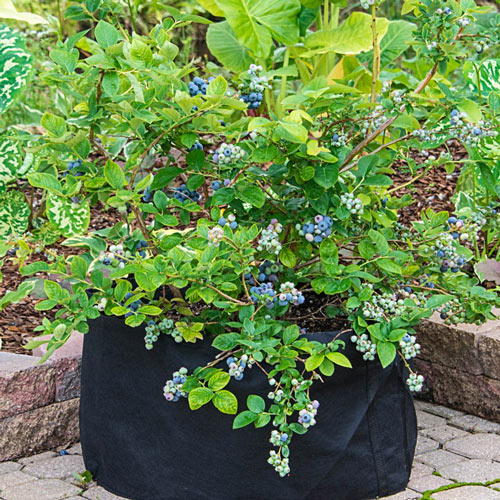In Praise of Potatoes
-
Helpful Products from Gardens Alive!
-
 Grow Tub® 20 Gallon Garden Container
Grow Tub® 20 Gallon Garden Container -
 Potatoes Alive!™ Fertilizer
Potatoes Alive!™ Fertilizer
Prelude: Before we get to your questions, I want to emphasize one thing: Plant and Grow Potatoes this year. Yes, organically grown potatoes are widely available and inexpensive, but nothing can replace the sensation of unearthing a fresh home-grown potato, rinsing it off and biting into it, right there in the field. If you have never grown potatoes, you have never really tasted a potato.
Q. Deanna in West Point, Virginia (near Williamsburg) writes: "I am in perpetual learning mode; and I'm curious about the potato bags I see advertised. Do they really work well for white and sweet potatoes? We have voles and clay soil and are looking for feasible alternatives."
A. A little bit of back-and-forth emailing revealed that Deanna was talking about the flexible, foldable fabric "grow bags" that are [ahem] growing in popularity. For 'true' potatoes (sometimes called 'Irish potatoes' or 'spuds'), the answer is a loud "yes!" In fact, potatoes may be the ideal crop for these above ground 'bags'. But don't call them white potatoes. {quote} "White potatoes" like russets, are ideal for some uses (like the making of French fries, of which the best I've ever tasted were in Paris); but for home cooking, you want to grow gourmet varieties.
I now grow all my potatoes in grow bags, for their height, the ease of harvesting and the fact that they look good on the patio where the disintegrating decades-old half-whiskey barrels are being slowly removed. Some are planted with red potatoes, some are planted with buttery-gold varieties, like the fabled Yukon Gold, and some are planted with wonderful variations like red-skinned potatoes with golden flesh and gold-skins with red flesh.
But there are no white or purple potatoes in my garden. (I consider the purple ones a novelty that doesn't live up to the taste of red or gold.) And sweet potatoes are not potatoes of any kind. Related to Morning Glories (honest), they spread laterally on the surface as opposed to being straight up plants that do the hard work underground; so they do much better in a raised bed where the leaves can roam on the surface.
Q. Vina Jane in Coopersburg, PA writes: "Last year I planted potatoes; the plants grew but never flowered. Were those potatoes safe to eat? I heard the plant could be poisonous".
A. Potatoes that were poorly cared for and exposed to the sun will develop distinctive green areas that are toxic, not poisonous. You'd have to eat a lot of green potatoes to OD on them. Continuous mulching of your crop throughout the season prevents the problem. And if one energetic spud manages to break ground and go green, just cut off the green parts. If more than a third to one half of a potato is green, toss it.
Flowers are another story; and they are one of the most wonderful things about growing your own. When the above ground growth is just about fully grown, it will often (but not always) produce a flush of small flowers on one stalk above the plant. These flowers will reflect the color of the potatoes growing underground: red flowers for redskins, yellow flowers for 'gold' potatoes, bluish purple flowers for 'purple' potatoes and white flowers for (d'uh) white potatoes.
Lack of flowers doesn't mean anything; it happens. But the appearance of flowers (which are staggeringly beautiful) can be important. First, enjoy the flowers until they start to fade, then pinch them off (unless you want a green ball to appear in their place that contains potato seeds, which might produce potatoes in several years). Now take the calendar you use to remember things and mark a date three weeks to a month from then. That's when you can harvest small 'new potatoes' (aka fingerlings) that have concentrated taste and nutrition.
But you doesn't has to. You can let the plant alone until the first frost and then dig up and harvest full-sized potatoes. Be sure to 'root around' the general area; you can often find some big uns a foot or more away! Fun for the kiddos! Bring the harvest inside, gently brush the dirt off but do not wash them. Store them in a cool dark area; even ambient light can cause 'greening'.
Q. Denise; my {quote} "biggest fan in East Lyme, CT", writes: "I'm a healthcare worker in a Covid-ridden hospital and your podcast is the emotional escape I so desperately need on my hour-long commute home. Thank you. Now: This year is my first time trying potatoes. To my surprise, my mail-order spuds arrived without eyes, forcing me to desperately search google. This brought me to the term 'chitting'. I'm fearful of losing my 'window' to plant!!! To chit or not to chit, that is the question! Please help!"
A. Not without thanking you for your service first. You people have replaced the Justice League and The Avengers as my favorite heroes. Now: feel free to chit away! Many potato growers will place their soon to be planted spuds in a sunny windowsill or other bright area indoors a couple of weeks before planting in the hopes of getting an early harvest. When your planting stock is without eyes, this step is essential.
-
Helpful Products from Gardens Alive!
-
 Grow Tub® 20 Gallon Garden Container
Grow Tub® 20 Gallon Garden Container -
 Potatoes Alive!™ Fertilizer
Potatoes Alive!™ Fertilizer







 Gardens Alive! & Supplies
Gardens Alive! & Supplies




